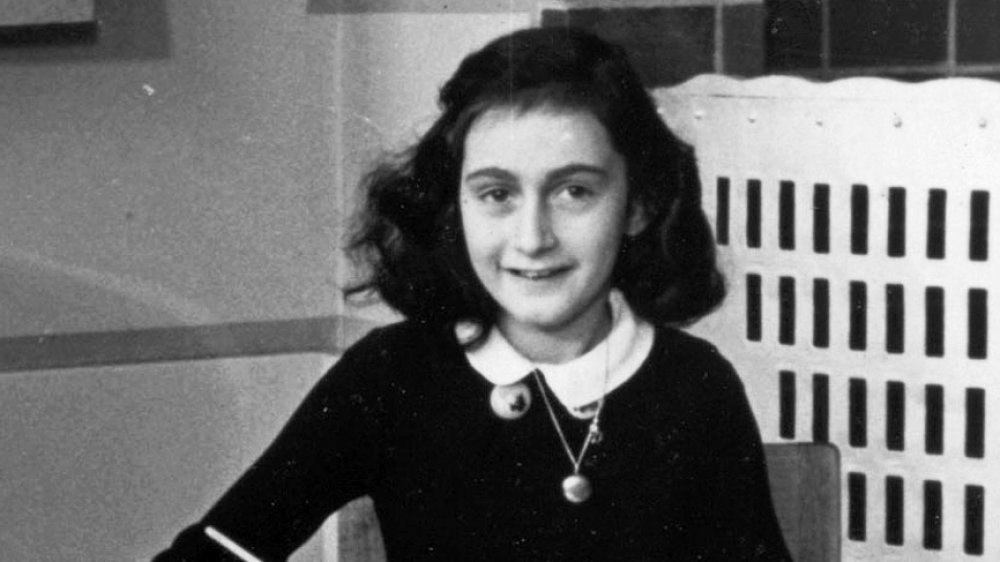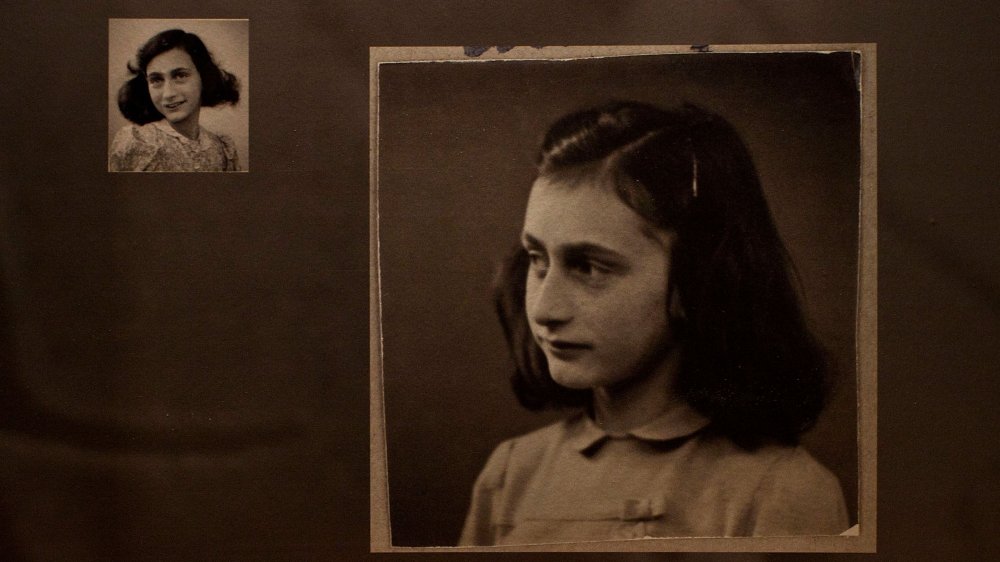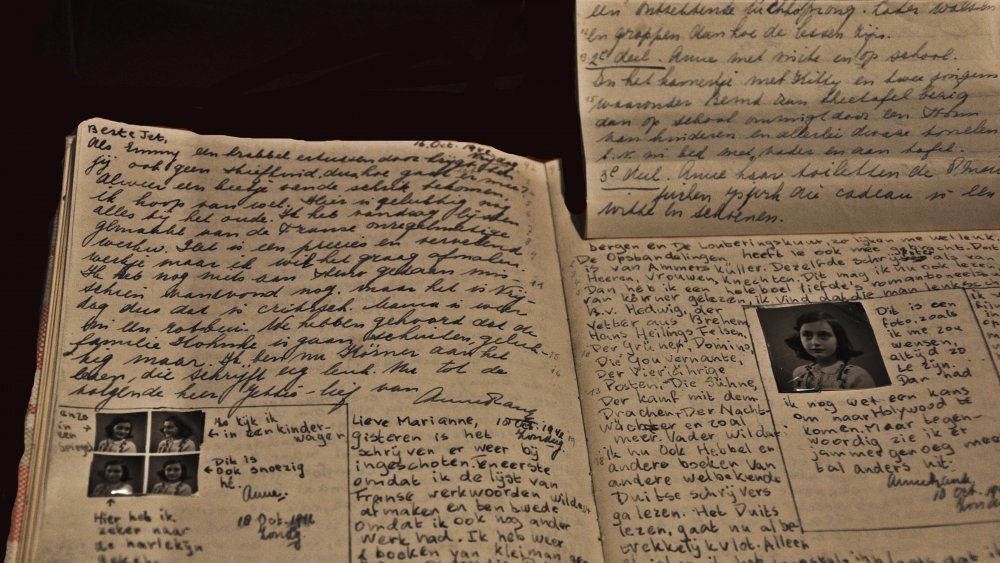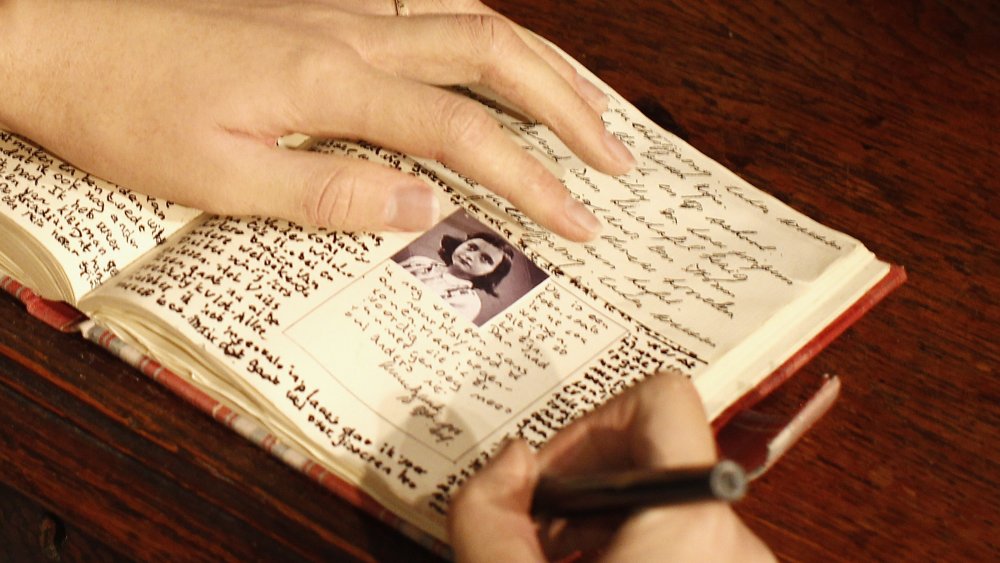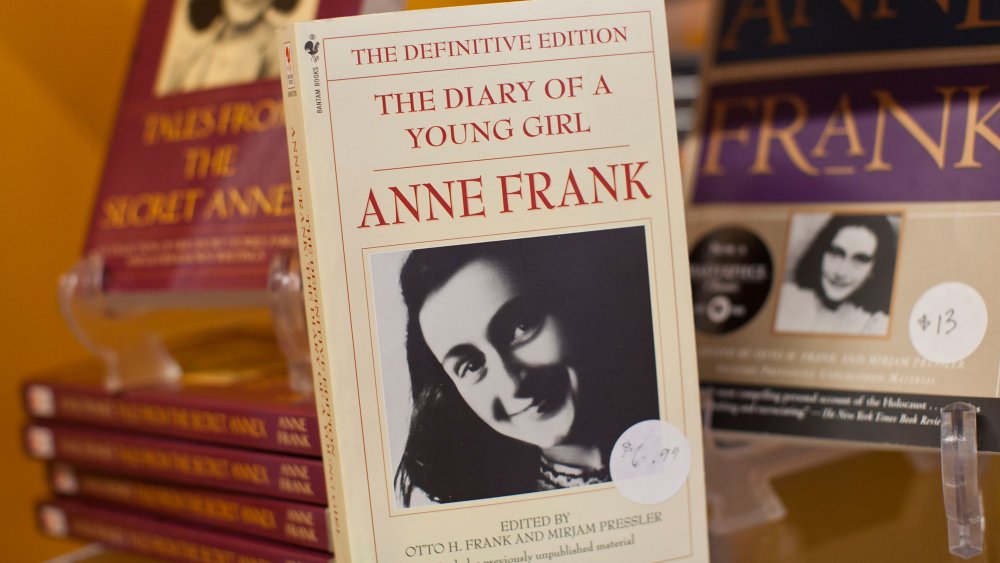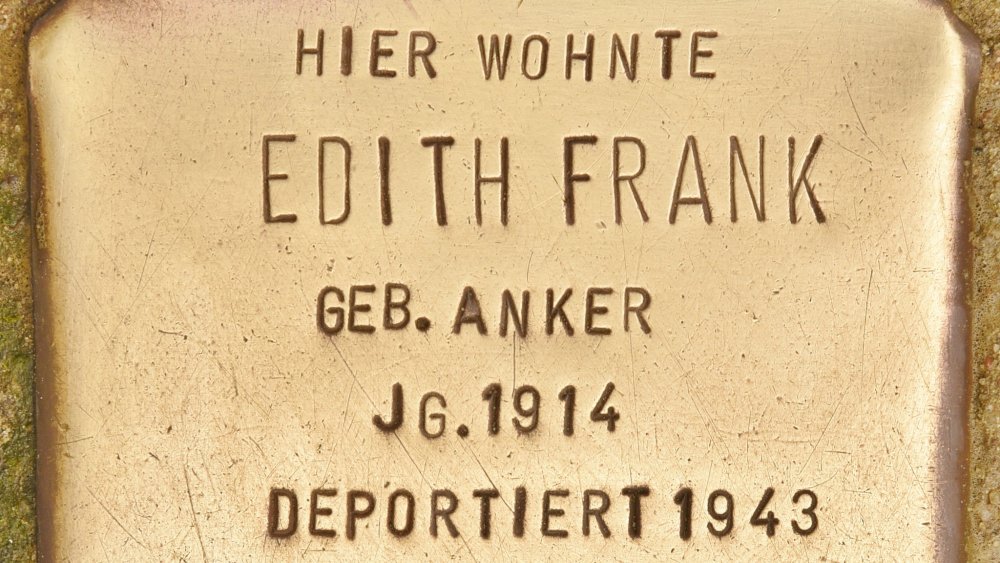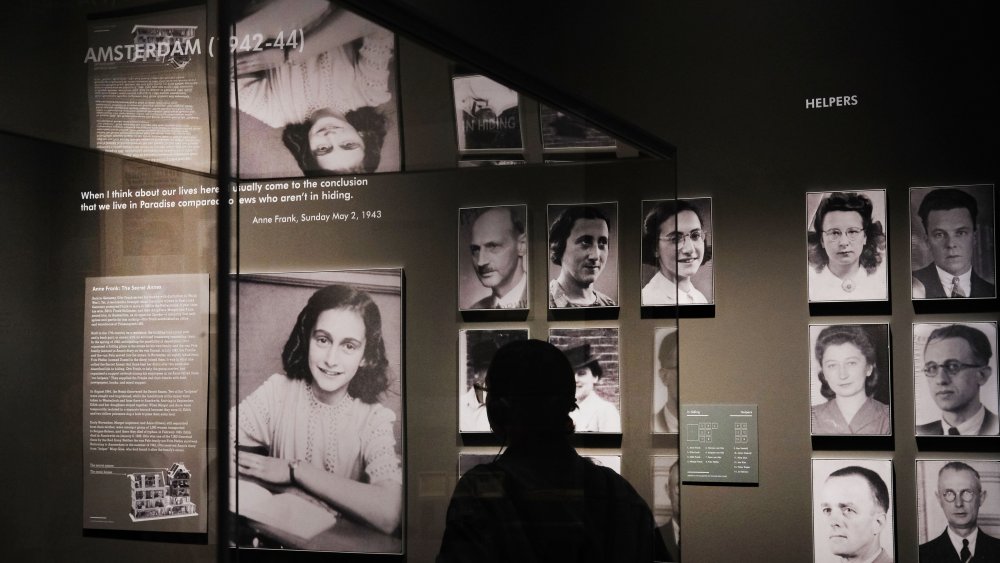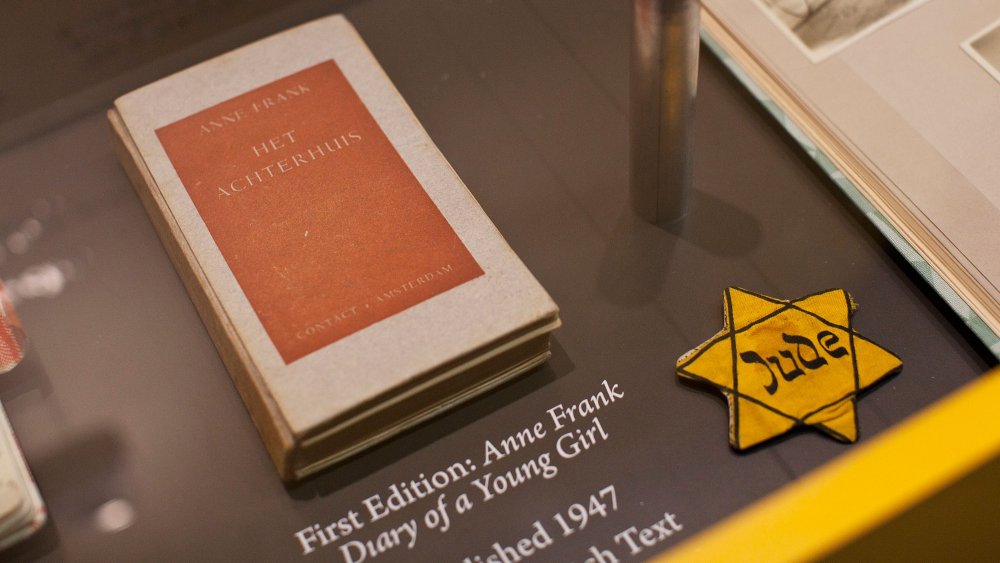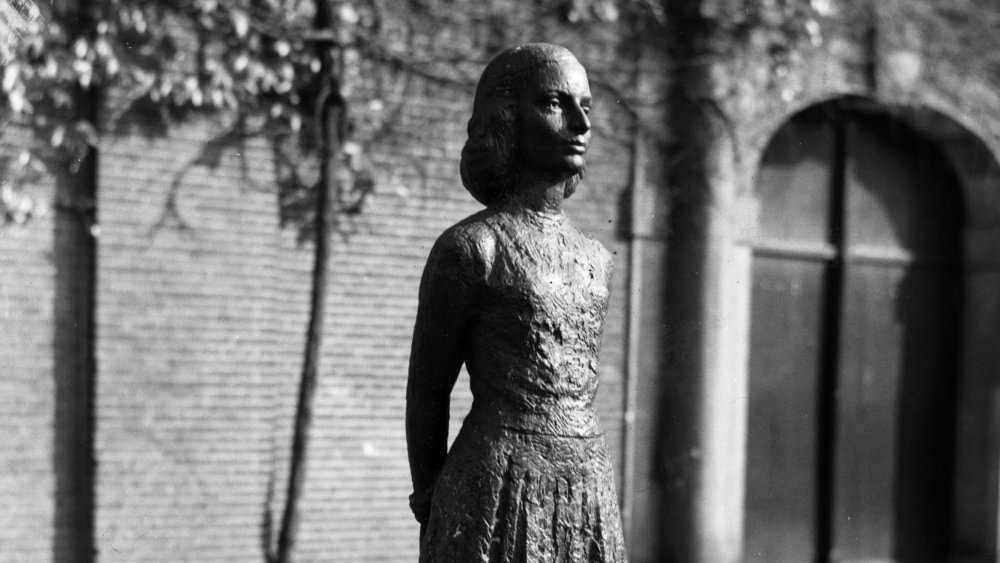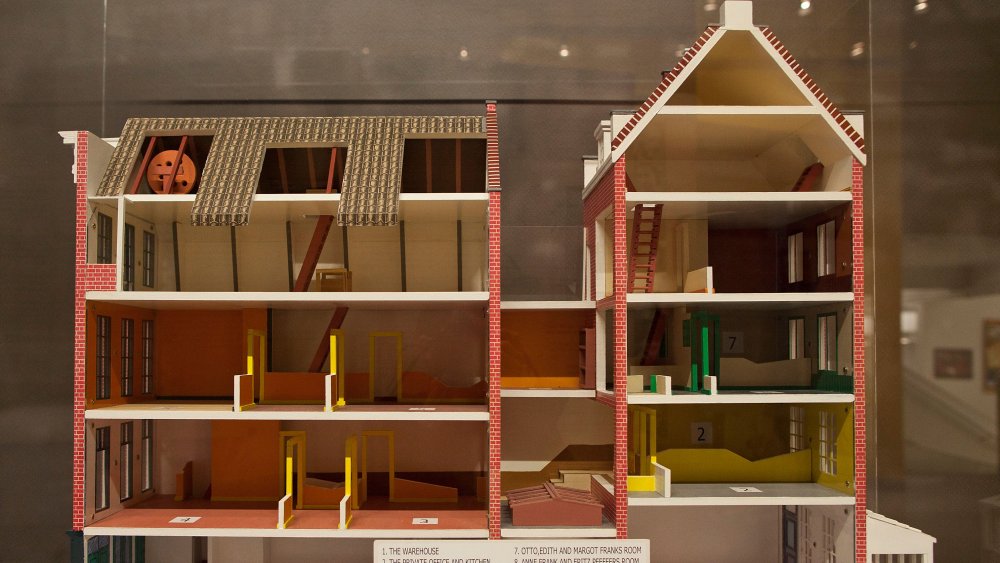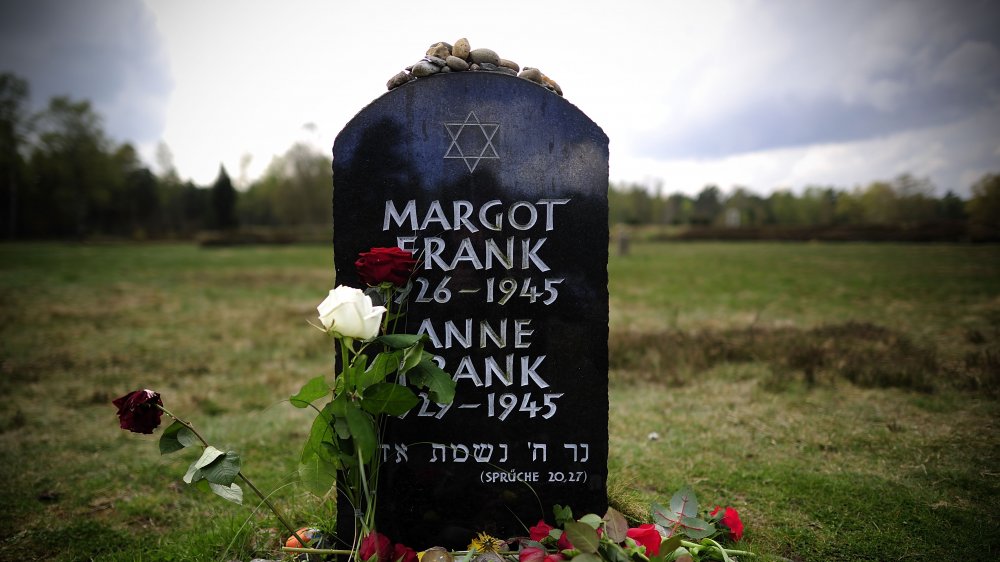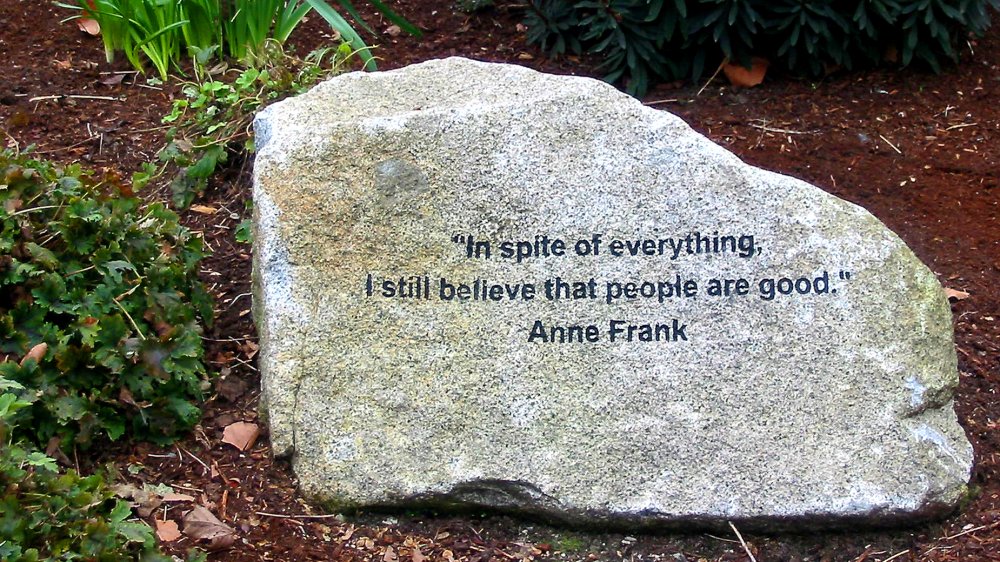Things Your History Class Didn't Teach You About Anne Frank
Right up there with the Egyptian pyramids or the Declaration of Independence, the story of Anne Frank is one of the most common lessons in American classrooms. A survey from the University of Michigan in 1996 found that over half of American high school students had The Diary of Anne Frank on their required reading lists. For over 70 years, the wise teenager's unfiltered chronicle of hiding in occupied Amsterdam has served as an introduction to the horrors of World War II.
Beginning in 1942, Anne Frank wrote from a concealed portion of her father's business that she called the Secret Annex, where she lived with seven other Jews. They were confined for over two years, until August 4, 1944, when Anne and the members of the Annex were arrested by the Dutch Secret Police. The group members were sent to Nazi concentration camps across Poland and Germany. At Bergen-Belsen camp, Anne Frank died of typhus in 1945. Otto Frank, Anne's father, was the sole survivor. This story would have remained untold if not for Miep Gies, who collected Anne's diary from the Annex and delivered it to Otto after the war.
History classes teach the story of Anne Frank as a triumph of the human spirit and innocence amid atrocity. However, these versions are too often sanitized. There was more to Anne Frank — secrets, admissions, goals — than the earliest versions of her diary revealed. Here are the things your history class didn't teach you about Anne Frank.
Anne Frank's exile began before her diary
Many think of Anne Frank's story as starting on July 6, 1942, when she went into hiding after her sister received a call-up notice to a labor camp in Germany. However, by the time she was 13, Anne's life had been upended by Nazism for almost a decade. Anne Frank was born on June 12, 1929, in Frankfurt am Main, Germany, but her German life was cut short with the rise of Hitler's regime in 1933. Pressed by anti-Semitic policies, the Frank family relocated to Amsterdam, with Anne arriving by February 1934.
Anne Frank attended a Montessori school with a mixed peer group until Germany invaded the Netherlands in 1940. Kicked out of public school for being Jewish, Anne was made to attend the all-Jewish Lyceum school. Anti-Semitic policies leached into Dutch life: Jews couldn't take public transportation, sit on park benches, or be out in public after 8 p.m. An edict issued in May 1942 forced all Jewish people over six to wear a yellow Star of David, per ThoughtCo. "She was not yet four when the German persecutions of Jews began, and from then until the anguished close of her days she lived as a refugee and a victim," The New Yorker explains.
Recognizing that what happened in Germany could happen in the Netherlands, Edith and Otto Frank gradually moved their belongings from their home at 37 Merwedeplein to Otto Frank's business at 263 Prinsengracht, preparing to hide.
Anne Frank wanted a pseudonym
After World War II, Otto Frank took his daughter Anne's salvaged diary and prepared it for publication. However, the Dutch version, published in 1947, was something of a collage of Anne Frank's writings, including the removal of some sensitive material.
Among the liberties that her father Otto Frank took when preparing Anne's diary was his choice to use the Frank family's real names. Anne Frank had originally chosen the pseudonym Anne Aulis and later Anne Robin for herself in her diary, according to ThoughtCo. Her sister Margot was called Betty, her mother Edith was named Nora, and her father Otto was referred to as Frederik.
Peculiarly, it was only the other members of the Secret Annex who were left with the original pseudonyms that Anne had given them. Readers of the diary know Albert Dussell, who was really the dentist Freidrich Pfeffer, and are familiar with the van Daans, who were actually known as the van Pels. Historians will never be certain why Anne Frank chose these pseudonyms for herself and the other Annex inhabitants, but it's most likely that she was trying to protect the identities of the Jewish families hiding illegally during the Nazi occupation. Today, Anne Frank would marvel that her name is synonymous with Jewish resistance, as she had only ever meant to be known as Anne Robin.
Anne Frank suffered from serious mental health issues
One of the most outrageous mischaracterizations of Anne Frank was that she was an eternal optimist. In fact, Anne Frank is often known for her idealist quote, "In spite of everything, I still believe that people are good at heart," from her diary. The 1955 Broadway play based on her story helped to perpetuate this idea of a "funny, happy, hopeful" Anne, as The New Yorker notes.
However, focalizing on this one sentence misrepresents Anne Frank's trauma and minimizes the fear and grief experienced by those in hiding. As her stay lengthened, Frank struggled to dream of a life after the Holocaust. Frank wrote sharply about her suffering. "A deathly, oppressive silence hangs over the house and clings to me as if it were going to drag me into the deepest regions of the underworld," she stated in an October 1943 entry.
By the fall of 1943, Anne Frank was being treated for depression and anxiety, given drops of valerian, dextrose, cod liver oil, brewer's yeast, and calcium for her symptoms. Frank's mental health issues were a valid response to living in captivity for 26 months while millions around her were systematically arrested, deported, and murdered.
Anne Frank was writing with you in mind
If you think of Anne Frank's diary as an incredibly personal artifact miraculously salvaged from a Nazi raid, you'll be surprised to learn that she wrote it with an audience in mind.
On March 28, 1944, Anne Frank heard a broadcast on the radio by exiled Dutch minister Gerritt Bolkestein urging that citizens create personal accounts of the historical moment to have as a record of German occupation, as told by Anne Frank House. After this, Anne set to work editing her diary entries, adding context, and copying an estimated 50,000 words onto loose sheets of paper. Between the two versions are stylistic adjustments that show her growing maturity as a writer. She planned for her edited diary to be titled Het Achterhuis, or The Secret Annex.
In addition to her now-famed diary she called Kitty, Anne Frank wrote prolifically in confinement, including 34 fairy tales, a Book of Beautiful Sentences, and an unfinished novel called Cady's Life.
So, no, Anne Frank's meticulous reworking of her diary was not merely an adolescent hobby. In her diary, Anne Frank expressed her wish to become a professional journalist after the war. She was critical about her skills as a writer but determined to achieve greatness. "I want to be useful or bring enjoyment to all people, even those I've never met. I want to go on living even after my death!" she wrote.
Anne Frank had mom issues
Tensions were high between Anne Frank and her mother Edith. Like many teenagers, Anne clashed with her mother and used her diary to let off steam. In the earliest versions of her diary, particularly before 1944, Frank made some unflattering remarks about her mom: "Mother has said that she sees us more as friends than as daughters. That's all very nice, of course, except that a friend can't take the place of a mother. I need my mother to set a good example and be a person I can respect, but in most matters, she's an example of what not to do," she wrote on January 6, 1944. In other parts of the diary, Anne mentions imagining her mother dying one day and her growing contempt for her.
As Anne Frank copied her diary for the second version, Het Achterhuis, she omitted many harsh passages about her mother, as Anne Frank House notes. Frank reflected that, "The period of tearfully passing judgment on Mother is over, I have grown wiser." A lot of growth can happen between the ages of 13 and 15.
Anne Frank was a normal teen
Anne Frank was 13 when she went into hiding, so it's not surprising that her writing contains a certain fascination with her own changing body. When she was editing the second version of her diary, Anne removed some of the explicit material herself. But the lion's share of the censorship came from Otto Frank, who, in the interest of not offending any conservative readers or harming his daughter's legacy, edited out many of the sex-related entries in the late 1940s, per The New Yorker.
In 1995, an unabridged "Definitive Edition" version of Anne Frank's diary was published, and it included passages that provide a more nuanced, human version of a curious, sometimes lustful, young girl. Early on, Anne Frank relays that she wishes she could begin to menstruate soon. In another very graphic passage, Frank details the female anatomy: "You can barely find it, because the folds of skin hide the opening. The hole's so small I can hardly imagine how a man could get in there."
According to NPR, this uncensored account of sexual anatomy has sometimes caused The Diary of Anne Frank to be banned in some schools. Complaints about this so-called "pornographic" material have come from school districts in Michigan as recently as 2013, as The Guardian reported. These passages highlight that Anne Frank was not a stock martyr but a regular teen who was robbed of adulthood.
We don't know Anne Frank's whole story
The "diary" part of The Diary of Anne Frank is a misnomer. The work as we know it was actually a series of notebooks repurposed for her personal writing, including an autograph album and two school exercise books. The famous red-and-white-checkered book we know as the iconic "diary" was started on June 12, 1942, and its last entry was made on December 5, 1942. This was the diary Anne Frank received for her 13th birthday, which she herself had chosen at a shop before knowing she would go into hiding.
The next school exercise book covered December 22, 1943, to April 17, 1944, and the third covered April 17, 1944, until a few days before her arrest on August 4, 1944. Do you see anything missing? Historians believe that a missing notebook covering the majority of 1943 was never uncovered. Nobody knows how this second notebook was lost, but fortunately, much of the content was likely reproduced in Anne Frank's preparation of The Secret Annex.
As ThoughtCo points out, Anne Frank would have needed that missing notebook to make her rewrites in 1944, but there is no definitive way of knowing when the notebook went adrift. As Anne Frank liberally reworked her entries, like removing her love for Peter in her later draft, there's no way of knowing what details never made it out of that notebook.
Anne Frank may have been discovered by chance
For decades, the theory has been that the raid on the Secret Annex that led to the arrest of its eight members was caused by a betrayal on the outside. Historians believed that the Sicherheitsdienst received an anonymous call, tipping them off about the hidden Jews at 263 Prinsengracht, as the BBC reports. Even Otto Frank, the sole survivor from the Annex, believed it was Willem van Maaren, a worker in the warehouse as of 1943, who made the call. However, these theories have never been substantiated.
A study released in 2016 presents the possibility that the Sicherheitsdienst arrived at the Secret Annex because they heard of illegal work and fraud with ration coupons taking place within the building. In fact, in March 1944, Anne Frank wrote of the arrest of two men, thought to be Martin Brouwer and Pieter Daatzelaar, who dealt illegal ration cards within the very same building as Otto Frank's business. Anne even alludes to her family getting their ration cards from these men and running out of their clandestine supply once they were arrested.
Could it be that what was once believed to be betrayal was actually a ration fraud raid? Per the study, the August 4, 1944, raid reportedly lasted about two hours — a seemingly long time for arresting Jews in hiding.
Anne Frank told dirty jokes
"Do you know why the German girls of the armed forces are in the Netherlands? As a mattress for the soldiers."
You'd probably never expect such a ribald joke from Anne Frank, but that's exactly what scholars uncovered from her diary drafts. Reported in May 2018, new photo-imaging software revealed two pages from Anne Frank's diary that had been covered by adhesive brown paper. Biography states that the entries were originally written on September 28, 1942, and included four dirty jokes, five crossed-out sentences, and a reference to her father having visited sex workers in Paris. Frank also implied that her Uncle Walter may have been gay, as the Times of Israel reported.
While readers of The Diary of a Young Girl are by now familiar with Anne Frank's wry humor, this was clearly a side she had intended to cover up as she went through her diaries. "Anyone who reads the passages that have now been discovered will be unable to suppress a smile," Frank van Vree, director of the National Institute for War Documentation, told the Times of Israel. "They make it clear that Anne, with all her gifts, was above all also an ordinary girl."
The Secret Annex was no ordinary hiding place
The choice to go into hiding was not an easy one for Jews in Europe during World War II. As the United States Holocaust Memorial Museum notes, Jews in hiding had to leave behind their relatives and property, find helpers to secure their food and shelter, and risked punishment if caught by the Gestapo. Still, about 28,000 Jews went into hiding in the Netherlands of the approximately 140,000 in the entire country, per the Anne Frank House.
The accommodations of the Franks, however, were quite extraordinary: The entire family stuck together, they remained in one location in the city, they had five dedicated outside helpers, and they were mostly well-funded. Anne Frank was aware of her unique situation and wrote: "If I just think of how we live here, I usually come to the conclusion that it is a paradise."
Much more common was for Jews to hide out in the country, where some lived outside of homes, exposed to the elements. For example, a young Sarah Peretz Etons was forced to hide in a chicken coop for over two years in occupied Poland, as the Holocaust Memorial Museum remembers. Those at risk of being discovered had to flee, with the average Jewish child hiding in 4.5 addresses during the Holocaust, according to Anne Frank House. The Secret Annex, which spanned two floors and concealed eight people at the center of Amsterdam, was far from common.
Anne Frank died earlier than believed
The end of Anne Frank's life was indisputably tragic. After their August 1944 arrest, the Frank family was brought to Westerbork camp in the Netherlands. On September 3, Anne Frank was deported to Auschwitz in Poland. Then, Anne and sister Margot were separated from the rest and brought to work at Bergen-Belsen camp sometime in October 1944. It was here that Margot succumbed to typhus, a disease carried by lice, followed a few days later by Anne. It's long been held that Anne Frank died a mere two weeks before Bergen-Belsen was liberated on April 15, 1945.
However, as reported by USA Today, recent research shows that it's more likely that Anne and Margot died at Bergen-Belsen in February 1945. Nanaette Blitz, a former classmate of Anne Frank's who was held at Bergen-Belsen, reports that she saw Anne in early December, skeletal and crawling with lice. Auguste van Pels, an occupant of the Secret Annex, confirmed that he also witnessed the sisters in failing health in early February at Bergen-Belsen. With a raging typhus epidemic in the camp, it's unlikely the Frank sisters survived through February.
What is the significance of Anne and Margot Frank dying earlier than suspected? Researcher Erika Prins explained to The Guardian: "When you say they died at the end of March, it gives you a feeling that they died just before liberation. So maybe if they'd lived two more weeks ... Well, that's not true anymore."
At first, nobody wanted to publish Anne Frank's diary
To think one of the top 50 bestselling books of all time almost never made it onto the shelves. When Otto Frank was first handed his daughter's manuscripts in 1945, he was taken aback by her depth of feeling and her deft documentation of the war. As important as Anne's diaries were to him, Otto took convincing from close friends Jan and Annie Romein to finally compile and attempt to publish them, per the Anne Frank House. At first, editors were not interested in revisiting the traumas of the all too recent past. However, in 1947, the Dutch publishing house Contact released Anne Frank's writings as The Secret Annex.
Anne Frank's genius wasn't as warmly received across the Atlantic. In 1950, the publisher Alfred A. Knopf turned down the rights to the English-language version of the diary, finding the story unappealing. The reader's report said Anne Frank's work was, "a dreary record of typical family bickering, petty annoyances, and adolescent emotions," according to The New York Times. The Diary of a Young Girl was rejected by 15 other publishing houses before being rescued from the slush pile by editor Judith Jones at Doubleday. After devouring the manuscript, Jones told her boss that they simply had to publish it. Her boss replied, "What? That book by that kid?" Jones recalled to the Associated Press. Little did he know Anne Frank's diary would go on to sell more than 30 million copies.
